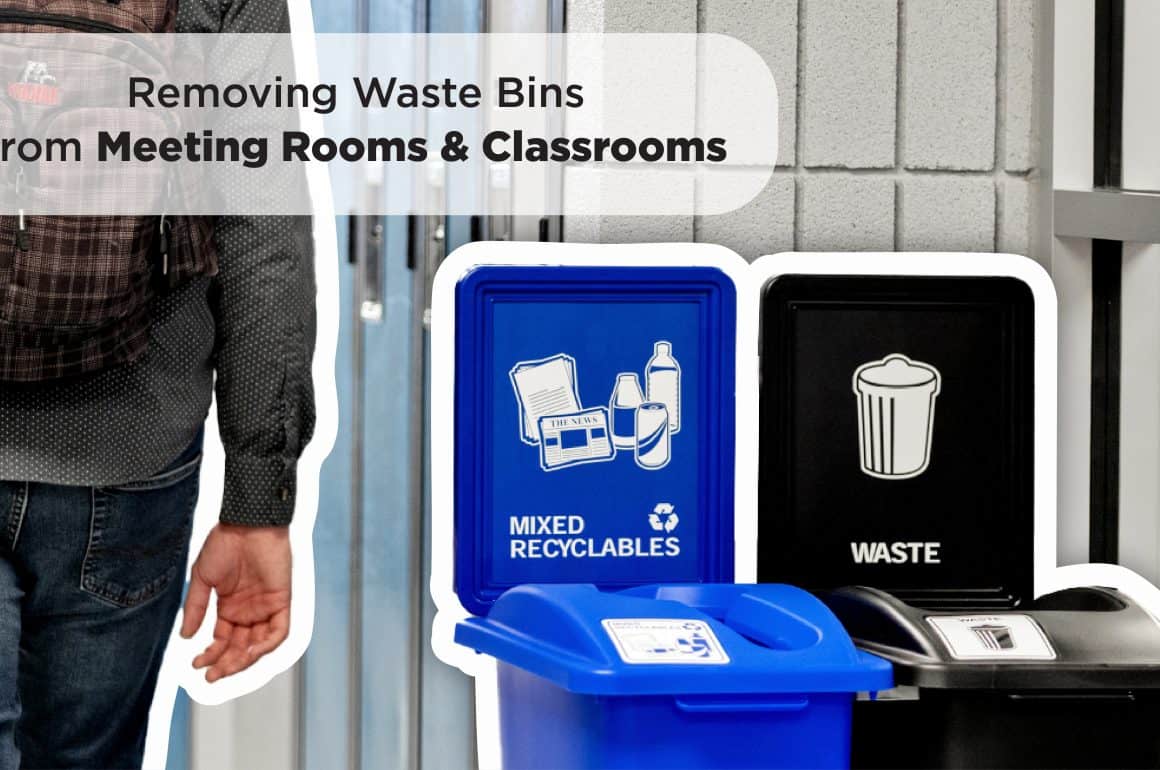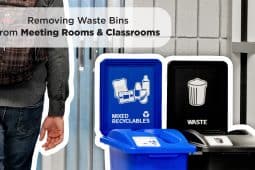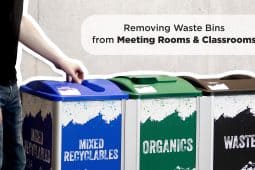Best Practices for Removing Bins from Classrooms
In part one of this blog, I described the growing trend towards “all-in-the-hall” collection arrangements that involves removing waste baskets from classrooms and meeting rooms in academic and workplace settings. These arrangements, which rely on people to carry their personal waste out to larger bins (typically 20 to 45 gallons) in hallways and other common areas, have been shown to increase waste diversion and lower recycling contamination. A 2024 survey of US and Canadian sustainability managers conducted by Busch Systems and several partners (Indoor Waste & Diversion Practices at Colleges & Universities) supported this point and shared strong evidence that this system saves money and frees custodial time to focus on more important cleaning tasks. However, if consolidating waste collections to common areas is a slam dunk operationally, the survey results also showed that careful planning is important to successfully implementing it.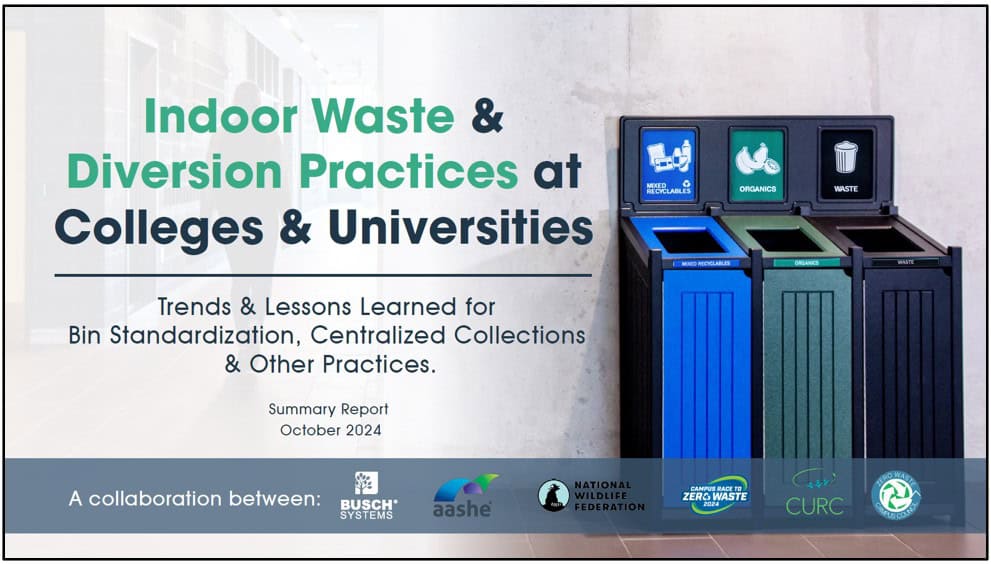
With part 2, I’ll share best practices and lessons learned about how to adopt an all-in-the-hall collection system. Similar to the other common example of the centralized collections concept, which requires office workers to carry their personal deskside waste to common area bin stations, removing waste baskets from classrooms and meeting rooms can generate controversy. Some people will complain about having to handle their own waste whereas custodians may have concerns about increased litter, or feel pressured to buck the new system. Overcoming these objections and achieving the best possible diversion and operational outcomes requires, among other things, close coordination with various stakeholders, modifications to the broader waste bin infrastructure, and a communication strategy to retrain students, faculty, and others to the new system.
Realigning Centralized Bins for the New System
Taking bins out of a room doesn’t eliminate the waste itself obviously. The same quantity of trash, recyclables, and organic waste will have to be absorbed by centralized bins in common areas. Designed to handle a lower volume of waste generated through different patterns of use, that network of centralized bins will need to be reconfigured to serve the new system.
There are four basic principles to planning a centralized bin network. Recycling (and to a larger extent compost, if your program diverts this stream) bins must be paired immediately next to trash in essentially all common area locations. There are incidental exceptions, but a key part of recycling behavior is reinforcing the expectation that people can and should do it wherever they go. Second, you must have enough collection capacity to handle the volume of waste being generated; capacity is determined by the number and size of bins, but also by the frequency of collection. A third guiding principle is to observe the patterns of use and waste generation in each area of a building; what activities take place, and how do they influence the volume and composition of waste produced in given location. Finally, bins must be placed in locations that are convenient and intuitive for the people using them; to avoid litter inside rooms, people need to have an expectation they’ll pass by bins soon after exiting.
With this in mind, one should follow the lead of Kent State University, which used their 2024 survey response to describe a process for evaluating bin infrastructure needs. Armed with a clip board, printed copies of floor maps and a pen, staff walk through a building methodically recording details about the existing network of bins: Where are they currently located and which waste streams are represented in each instance? What are their volume capacities? What condition are they in? How often are they emptied and which ones are consistently full or less so?
This same mapping process should record details for the reconfigured network. Where can bin stations be placed for proximity and clear visibility to people exiting each room? Where does the density and size of classrooms call for additional or simply larger bins? Do waste audits suggest a need for smaller or larger capacity bins for one waste stream over another in certain locations? Could a bin location block egress or become a fire hazard in an emergency?
Keep in mind some rooms produce quantities or types of waste that make it impractical not to provide waste bins. Think large lecture halls or labs, or event spaces that actively generate waste material such as lab glass or food packaging. In these cases, you’ll probably still want to provide bins inside the rooms themselves.
If you’re reorganizing the placement of centralized bins, it’s worth pausing to consider this infrastructure holistically. Waste and recycling infrastructure tends to evolve in an ad hoc fashion. Over time, the lack of design guidelines or coordinated planning results in a collection of mismatched bins and inconsistent signage representing different generations of investment. This legacy infrastructure both looks funky and breeds confusion. Though it’s not essential to adopting an all-in-the-hall system, this realignment process is also an opportunity to replace older bins and signage to fit a uniform design standard. For a deeper dive about bin standards, read this blog I wrote a few years back. 
Involve Stakeholders and Refine Your Plan
An all-in-the-hall system is a significant change that requires stakeholder input starting with custodial staff. The first thing you’ll likely hear is that removing classroom bins will lead to more litter and time spent cleaning rooms. It’s a legitimate concern, but one that can be avoided with careful planning. Several schools in the 2024 survey saw litter increase when classroom bins were removed. However, a much larger percentage, roughly 9 to 1, experienced either no change or a decrease in litter.
Beyond litter concerns, Contra Costa Community College District in California stressed the importance of studying custodial routines to ensure changes will streamline rather than complicate the collection process; get custodial as well as the building manager feedback about proposed new bin locations and consult others such as department heads, deans or office managers. Whether they have direct authority or not, being responsive to their input is important to designing an effective system and securing them as allies. As UNC Charlotte wrote “make a point of letting them know why you are making changes…they can help answer questions from others in their building. I can’t even begin to tell you how important relationships are in getting new programs implemented.”
Like any significant operational changes, there’s value to pilot testing the arrangement in isolated locations prior to full implementation. Pilots are your chance to work out the bugs, addressing litter, and other potential issues without the negative attention they’d otherwise attract with the full roll out. The University of Calgary noticed removing bins from inside larger theater lecture halls led to increased contamination in the bins just outside the entrance doors, prompting them to add extra centralized bins and do further educational outreach. UNC Charlotte ended up doing multiple rounds of pilots, further refining the basic model each time.
Invest the time to measure key baseline metrics before bins are removed from classrooms, work with custodial managers to track the time spent emptying both classroom and centralized bins in the hallway, have an intern walk through classrooms at the end of the day counting the number of litter items before custodians start their rounds, and do waste audits to measure changes in diversion and contamination rates. Some schools go as far as surveying professors and other stakeholders to gauge their experience; the data you gather builds evidence to help justify further expansion. Tracking impact data requires extra work but it serves a smart, long-game strategy. Fairly or unfairly, waste reduction initiatives are often viewed by decision makers as feel-good efforts that add costs and operational complexity, often without accountability to results. Data helps establish credibility and demonstrate the seriousness of the larger sustainability effort. The University of Montana and North Carolina State University were among the schools reinforcing this point, with Montana saying their centralized collection pilots became “a good foot in the door… to discuss further… sustainability and materials management efforts.” With their potential to document money and labor savings, centralized collections provide an opportunity to tell a powerful story, connecting sustainability to institutional priorities in the minds of decision makers.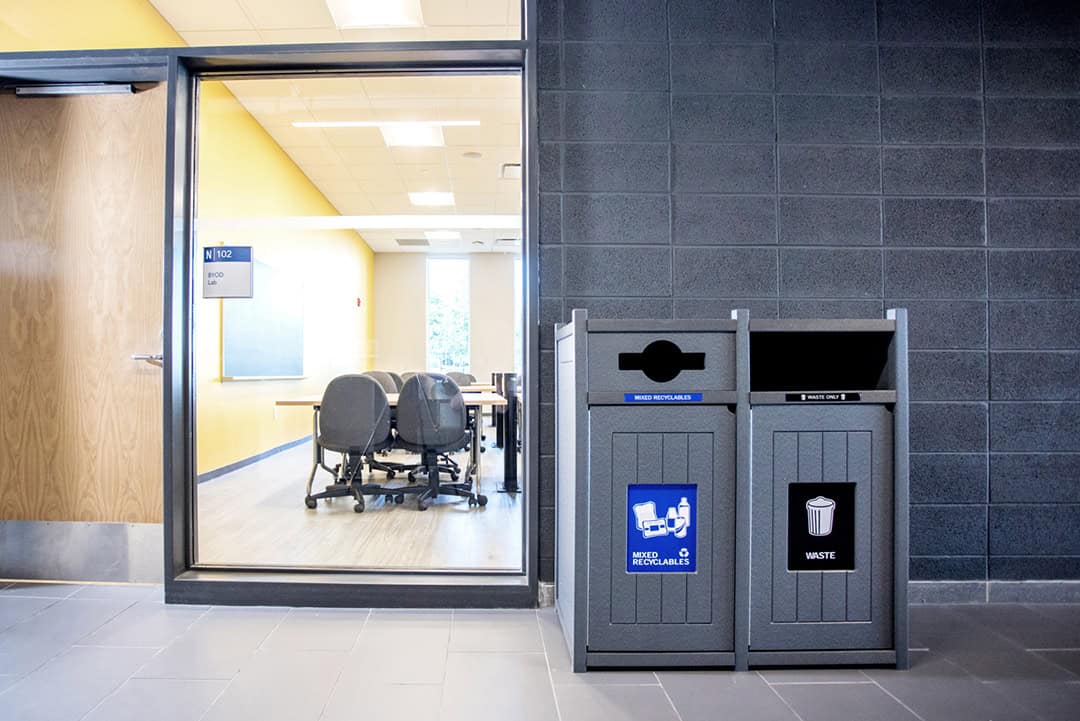
Develop a Rollout Strategy
With the pilot(s) done and a green light in hand, the next question is when and how to roll out the new system. Any seasoned sustainability manager will endorse a pro-tip that Winthrop University offered, “Remove trash cans from classrooms in the summer.” This allows students and faculty returning in the fall to experience the new system as an established default and reduces the risk of a mid-term change where, as UNC Greensboro noted, people perceive it as “taking away a convenience” they’ve developed a routine around.
Another pro-tip is to implement multiple significant changes together as a single, coordinated package. Change can be disorienting. Especially with a low-priority concern like waste, following one significant change with another soon after can generate confusion and lower people’s confidence with waste diversion efforts. If there are near-term plans to, say, convert from dual to single stream collections, add food compost collections, or revamp with new uniform bin labels, presenting them simultaneously allows people to focus on and adapt to program updates on a single occasion.
Implementation needs to be accompanied by pro-active outreach to people using the rooms. As Cal State Channel Islands observed, “communicating with the campus community about changes to waste bins is incredibly important. Especially for employees, people get very attached to their waste bins.” An outreach strategy needs to instruct people where to take their waste, explain the reasons for the change, and seek to preemptively address concerns.
Start with a courtesy notice to teachers and any other lower-level stakeholders that weren’t consulted during the planning stage. In a post to the Recyc-L listserv several years ago, Virginia Military Institute’s (VMI) recycling manager described their effort to place notes in professor’s mailboxes as well as provide department heads with an introductory script to read out at faculty meetings. They and others, including Johns Hopkins University and Portland State University, next placed signs in each room telling people to carry their waste to bin stations in the hallway. VMI went an additional step, providing student volunteers with a 30-second script to read out at the beginning of classes during the initial transition period.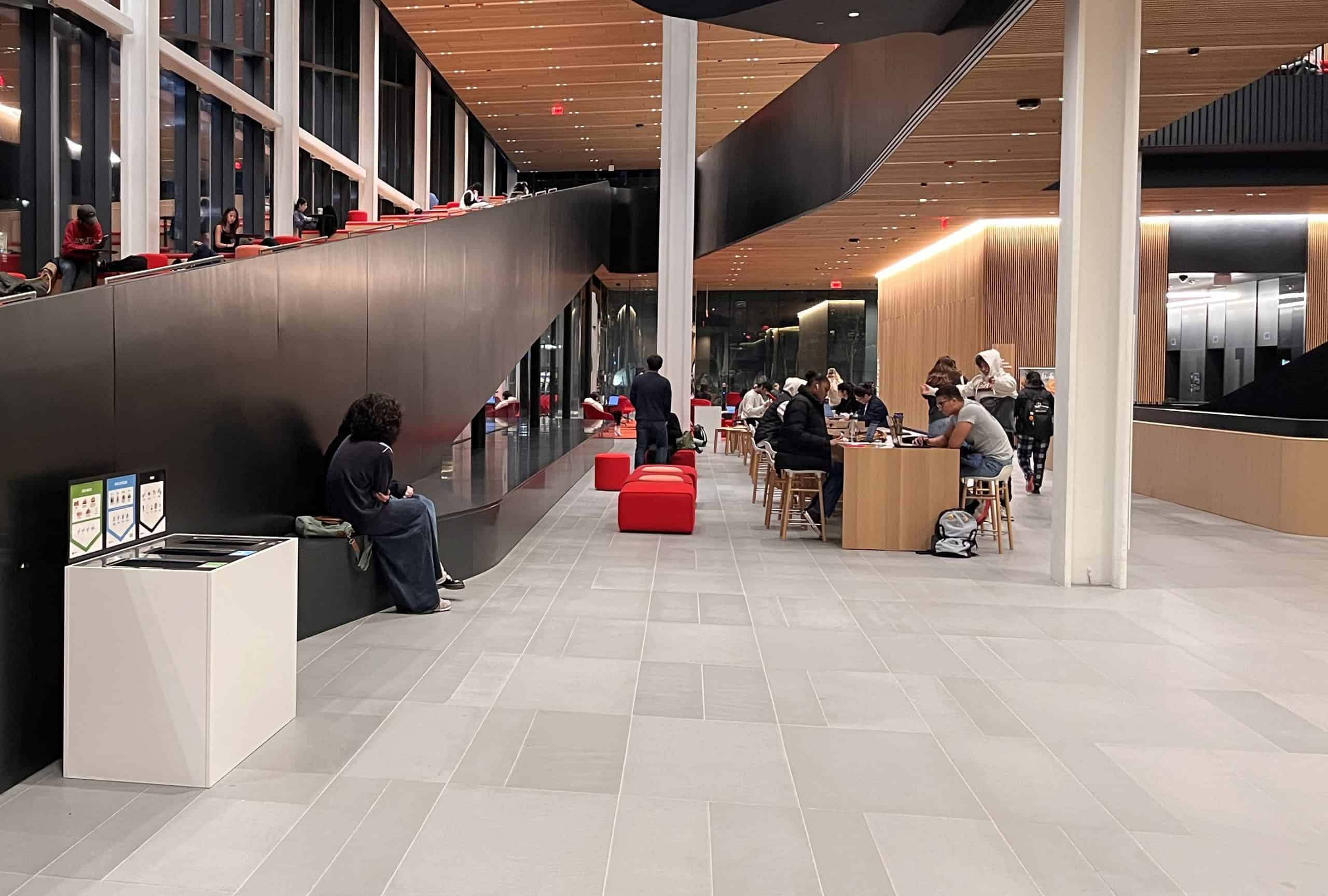
There may be overt complaints to a dean, but resistance most often takes a more passive-aggressive form. Sometimes it’s a custodian that believes bins are still necessary to deter litter, or it may be a frustrated professor taking matters into their own hands. You’ll want to follow implementation with periodic monitoring to intercept bins that mysteriously drift back into rooms.
Several schools offered a final pro-tip about supporting custodians. They are on the front lines and may feel they lack the power to refuse quiet pressure from professors or staff to revert to the status quo. Make sure they know someone has their back and will intercede when complaints get misdirected to them.
People Will Adapt
Decision makers often shy away from steps likely to draw controversy. Like the companion practice of eliminating custodial deskside waste service in offices, experience shows people will complain but also come to accept the all-in-the-hall system. Arguments focus on lost convenience, but often the actual, unstated offense is simply that it upsets established routine; people don’t like change.
But honest sustainability efforts require change; recycling and waste reduction are dependent on individual behavior. Legacy arrangements that make trash more convenient than recycling and compost presents an unnecessary structural barrier that disincentives sustainable behavior; without removing these barriers, “zero waste” is simply a marketing slogan.
